We understand people will be arriving earlier in the week and staying afterwards. We'd love to meet up beforehand. If you are interested in a get-together please contact the bride and groom.
Thursday, November 19th
- Tram Party 18:00 - 20:00 HKT; no more space available.
- Post-party Dinner 20:30 HKT (optional) At Yuet Wah Hui in Causeway Bay
- Post-dinner Desserts 10:00 HKT (optional) At ATUM desserant
For those going to the Tram Party, we will meet at the Island Line HKU station B1 exit at 5:30 inside the station. Please be there on time. Feel free to BYOB. We will be collecting money for the dinner/dessert in the Tram.
For those skipping the Tram, we will finish the party at 8:00 where it started, and then we will
all have to take the MTR towards Causeway Bay. Meet us at Yuet Wah Hui in Causeway Bay by 8:25.
Friday, November 20th
No arrangements; the groom and bride will need some rest.
Saturday, November 21st (The Big Day)
You will need to work out your own transportation to the Church. The closest MTR exits are Prince Edward or Mong Kok East. We recommend you get a taxi, as the church is a good 10-15 minute walk from the MTR.
We will provide a bus from St. Teresa's to YYC Club for the overseas guest lunch, and then back to the Empire Hotel TST and the Kowloon Shangri-La. Please do not leave anything on the bus either at YYC Club or in TST.
By local tradition, you are not expected to bring a gift to the wedding but instead a Red Envelope (also called lai see) filled with money. Most stationary stores in China sell Red Envelopes — they will not be provided for you at the wedding. Your gift should be in the currency of the wedding locale, unless the bride and groom specify otherwise, and the amount should not contain the digit "4" as it has the same sound as the word for "death" and is considered unlucky. You can write your best wishes for the couple on the plain red envelope and use that in lieu of a wedding card. However, if you prefer to give a wedding card, that would be welcome as well.
You can read this article for more information about how Chinese weddings differ from Western ones.
We know that Hong Kong is quite a haul for most of our guests,
so we've tried our best to provide some information on non-stop
flights from various palces where our friends and family reside:
Hong Kong offers visa-on-arrival for US passport holders.
Both  Cathay Pacific
and
Cathay Pacific
and  United Airlines
run non-stop service from EWR to HKG.
Cathay also runs non-stop service to Hong Kong from JFK.
The polar route generally takes between 15h30 and 16h00 and the
normal price range for a non-stop in November is $1100-$1300.
United Airlines
run non-stop service from EWR to HKG.
Cathay also runs non-stop service to Hong Kong from JFK.
The polar route generally takes between 15h30 and 16h00 and the
normal price range for a non-stop in November is $1100-$1300.
 Air China,
Air China,
 Asiana and
Asiana and
 Air Canada run
one-stops out of JFK and EWR via Beijing, Seoul
and Toronto, respectively.
We've heard some bad stories about both Air China and Air Canada,
and don't know much about the Korean Asiana, so you're up to your own
judgement for budget travel. Note however that transit through Beijing will
require a Chinese visa, which must be obtained at an embassy and is $140 for US citizens.
Air Canada run
one-stops out of JFK and EWR via Beijing, Seoul
and Toronto, respectively.
We've heard some bad stories about both Air China and Air Canada,
and don't know much about the Korean Asiana, so you're up to your own
judgement for budget travel. Note however that transit through Beijing will
require a Chinese visa, which must be obtained at an embassy and is $140 for US citizens.
Cathay Pacific is the top local Hong Kong airline and is considered
among the top in the world in terms of service. Many prefer the
Cathay flights, but their long haul seats tend to be slightly more
narrow than US airlines.
Hong Kong offers visa-on-arrival to all Japanese passport holders.
 Cathay Pacific,
Cathay Pacific,
 ANA (All Nippon Airways), and
ANA (All Nippon Airways), and
 JAL (Japan Airlines) all
run nonstops from both HND and NRT.
A normal price for November is around ¥55k to ¥60k, and the flight takes around 5h.
We don't recommend taking any of the one-stop options; they are a bit cheaper but they double the transit
time and for those of you who want to stretch your legs the non-stop is quite short already.
JAL (Japan Airlines) all
run nonstops from both HND and NRT.
A normal price for November is around ¥55k to ¥60k, and the flight takes around 5h.
We don't recommend taking any of the one-stop options; they are a bit cheaper but they double the transit
time and for those of you who want to stretch your legs the non-stop is quite short already.
Hong Kong offers visa-on-arrival to all EU passport holders.
Unfortunately, there are no non-stop flights to Hong Kong from LIS,
but there are a great many options for one-stop. The deals around €500 - €600.
In terms of places to transit, Dubai is just about the midpoint, with each segment taking
roughly 7h to 7h30, but the cheapest flights tend to
be the
 Lufthansa flights
that stop in FRA or the
Lufthansa flights
that stop in FRA or the
 British Airways
flights that transit in London. The longer second leg is 11h and
11h30, respectively.
British Airways
flights that transit in London. The longer second leg is 11h and
11h30, respectively.
Hong Kong offers visa-on-arrival to all Canadian passport holders.
Both  Cathay Pacific and
Cathay Pacific and
 Air Canada run
non-stop service to HKG out of YVR for around
$900 - $1100 CAD. The flight takes about 13h30.
Air Canada run
non-stop service to HKG out of YVR for around
$900 - $1100 CAD. The flight takes about 13h30.
 United Airlines also runs
a one-stop via SFO for around $700 to $800 CAD, but
the SFO → HKG leg is 14h, about 30m longer than the direct flight.
United Airlines also runs
a one-stop via SFO for around $700 to $800 CAD, but
the SFO → HKG leg is 14h, about 30m longer than the direct flight.
Hong Kong offers visa-on-arrival to all EU passport holders.
Both  Cathay Pacific
and
Cathay Pacific
and  Air France offer
non-stop round trip between CDG and HKG
for around €600 to €700. The non-stop from Paris is about 11h30.
Air France offer
non-stop round trip between CDG and HKG
for around €600 to €700. The non-stop from Paris is about 11h30.
A lot of our guests have already expressed an interest in taking
the opportunity to travel to other countries in Asia.
If you are already a frequent flier with one of the airlines
that offer a lot of flights from HKG (Cathay Pacific,
British Airways, United, etc.), they offer special fares if you want
to visit several countries during your trip.
- One World (Cathay Pacific, British Airways) has an "Around the World" fare.
- Star Alliance also has a "Round the World" fare.
We also suggest you look at the local fare
comparison site Zuji as there are a lot of good travel packages and low
cost travel options in Asia.
Central & North Asia - China, Japan, Korea
We've traveled extensively in this region and would be happy to provide some
tips for good areas to visit based on our experience and our connections.
Southeast Asia - Vietnam, India, Cambodia, Thailand
Javian Travels specialize in SE Asia
trip planning. When you contact them, mention our wedding, and they will be able to
tailor the travel options based on the wedding dates and your needs.
Getting to Kowloon Shangri-La
The most convenient way to get to Kowloon Shangri-La is to use the MTR
to head towards the Tsim Sha Tsui or Tsim Sha Tsui East stations. You can get there either on the Tsuen Wan Line or the West Rail Line.
- from Hong Kong Island: use the Island Line and transfer to the Tsuen Wan Line at Central. Get off at TST.
- from the Airport: From the Airport Express transfer to the Tung Chung Line towards Hong Kong in Tsing Yi (1st stop). Then, transfer to the West Rail Line towards Hung Hom in Nam Cheong. Get off at East TST.
The TST and TST East stations are connected to eachother via a system of underground passages and share the same system of exits. The best exit to get out of is P1.
If you are using a Red Cab or an Uber, the driver should be able to get you to Kowloon Shangri-La by themselves. Please be sure to say Kowloon Shangri-La, and not just Shangri-La, as there is a Shangri-La on Hong Kong Island as well.
The MTR operates
express service from the Airport to
Kowloon Station on the peninsula or
Hong Kong Station on Hong Kong Island. From there you
can transfer to MTR underground stations Austin (a bit of a walk) and Central,
respectively, or pick up a number of bus options or taxis. For transport back to the
airport, you can check your bags in at these train stations, so they are very
convenient. It's highly recommended you get an
Octopus Card
if you plan on travelling by rail: they are incredibly convenient, and you can return
them to get a refund on your 50HKD deposit.
There is also Taxi and bus
service from the airport. Taxi fares range from 200-350HKD depending on which area you
are staying in, whereas busses are generally going to be 20-40HKD.
There are lots of options for transport within Hong Kong.
There are plenty of two-tone red and white cabs in Kowloon and Hong Kong (and Green & White cabs in the New Territories).
The prices have been rising steadily the past few years. They will cost around $22HKD to get
in, roughly the same as a NYC Yellow Cab but far cheaper than a London Black Cab or a Tokyo Taxi.
This gets you 2km (often enough), but the price after that much slower than in New York at
$8HKD/km. Uber is also an increasingly popular
option as cabs have been increasingly gaining a reputation for (illegally) refusing
customers based on their destination.
Hong Kong has one of the busiest and most modern metro systems in
the world in the MTR. There is an RFID based prepaid fare system
called the Octopus card which we highly recommend as it simplifies travel
immensely: if you have used the Oyster card (London), Suika (Tokyo),
Upass (Korea) or Ventra (Chicago) you will find the system familiar.
The MTR charges based on distance, but trips are generally cheaper than the
flat fare in the NYC Subway. The MTR is the most convenient way to get around
for visitors, but gets very crowded during rush hour.
Hong Kong is one of the worlds food paradises —
from traditional Chinese food, east-meets-west fusion and
European Cuisine, Hong Kong has top class restaurants for
a variety of tastes. Here are some of our recommendations:
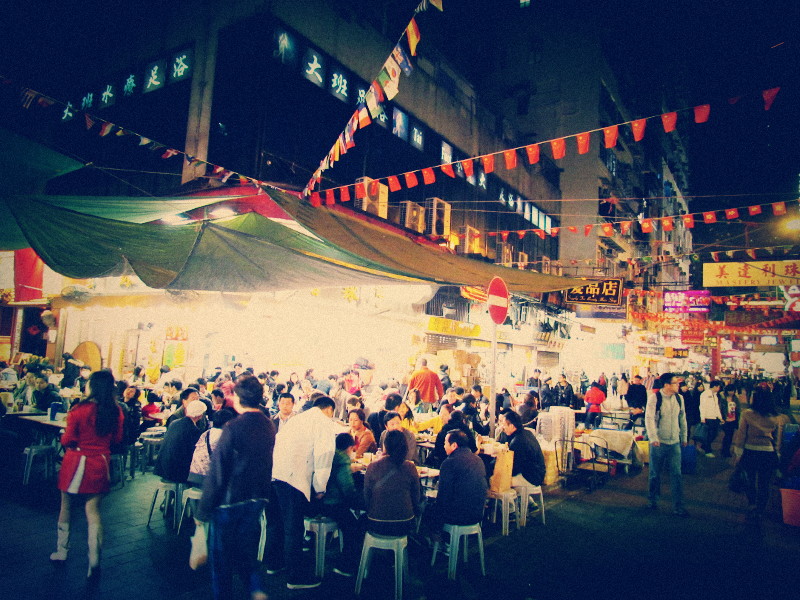 The Temple Street Night Market closes off the street at night to serve a variety of local dishes and seafood on the street. Cheap, good food with a bustling atmosphere.
The Temple Street Night Market closes off the street at night to serve a variety of local dishes and seafood on the street. Cheap, good food with a bustling atmosphere.
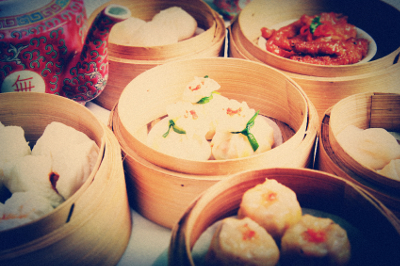 Dim Sum is the most famous regional
cuisine of Hong Kong, enjoyed in the morning and early afternoon. It's served in a variety
of places, from fancy and extravagant hotels to quick and cheap holes in the wall.
For a local, down to earth experience, try
One Dim Sum in Prince Edward,
Tim Ho Wan in Sham Shui Po, or for Hong Kong Island
DingDim 1968 in Central/SoHo and
蓮香樓 Lin Heung Kui in Sheung Wan.
Dim Sum is the most famous regional
cuisine of Hong Kong, enjoyed in the morning and early afternoon. It's served in a variety
of places, from fancy and extravagant hotels to quick and cheap holes in the wall.
For a local, down to earth experience, try
One Dim Sum in Prince Edward,
Tim Ho Wan in Sham Shui Po, or for Hong Kong Island
DingDim 1968 in Central/SoHo and
蓮香樓 Lin Heung Kui in Sheung Wan.
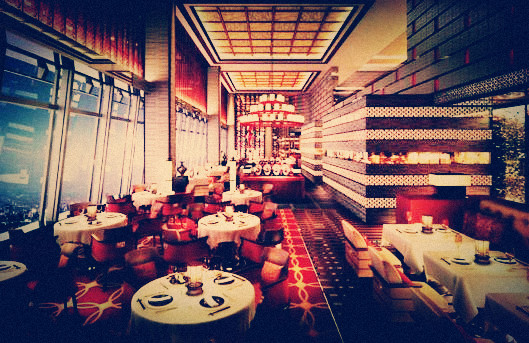 For a more upscale experience, try the dim sum at the 2-Michelin Star rated
The Shang Palace @ Kowloon Shangri-La in TST,
which is the hotel where the banquet will be taking place. Also in Kowloon is
Tin Lung Heen
which will offer great views of Hong Kong Island from the 102nd floor of
The ICC, the tallest building
in Hong Kong and the 9th tallest building in the world. Another Kowloon spot is
the Michelin Starred
Ming Court. For
Hong Kong Island, try the more traditional vintage
Luk Yu on
Stanley st. in Central.
For a more upscale experience, try the dim sum at the 2-Michelin Star rated
The Shang Palace @ Kowloon Shangri-La in TST,
which is the hotel where the banquet will be taking place. Also in Kowloon is
Tin Lung Heen
which will offer great views of Hong Kong Island from the 102nd floor of
The ICC, the tallest building
in Hong Kong and the 9th tallest building in the world. Another Kowloon spot is
the Michelin Starred
Ming Court. For
Hong Kong Island, try the more traditional vintage
Luk Yu on
Stanley st. in Central.
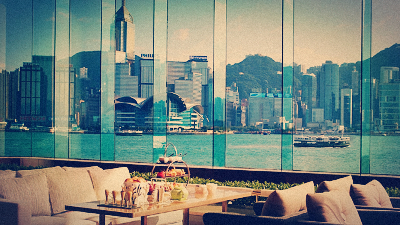 Owing both to its colonial heritage and to its local afternoon tea traditions
(Dim Sum is typically called yum cha, meaning drink tea),
afternoon tea
is also a popular past time. For a beautiful harbour view and the option of a
British or a Chinese themed set, go to the Lobby Lounge at the Intercontinental which features a live jazz band.
For a more classical British feel try The Peninsula
across the street and its string quartet accompaniment.
Owing both to its colonial heritage and to its local afternoon tea traditions
(Dim Sum is typically called yum cha, meaning drink tea),
afternoon tea
is also a popular past time. For a beautiful harbour view and the option of a
British or a Chinese themed set, go to the Lobby Lounge at the Intercontinental which features a live jazz band.
For a more classical British feel try The Peninsula
across the street and its string quartet accompaniment.
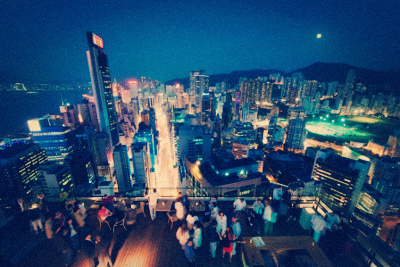 There are plenty of places in both Hong Kong Island and Kowloon to enjoy a drink out with
a view. Aqua and the ICC Ritz Carlton's rooftop
Ozone
both provide great harbour views while Australian steak house Wooloomooloo Prime has a
location in TST
and one across the bay
in Wan Chai with outdoor decks that offer beautiful views of the island and midlevels, respectively.
There are plenty of places in both Hong Kong Island and Kowloon to enjoy a drink out with
a view. Aqua and the ICC Ritz Carlton's rooftop
Ozone
both provide great harbour views while Australian steak house Wooloomooloo Prime has a
location in TST
and one across the bay
in Wan Chai with outdoor decks that offer beautiful views of the island and midlevels, respectively.
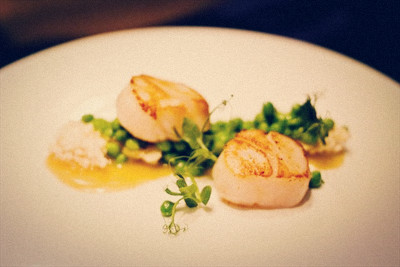 As the latest Michelin Guide to Hong Kong would suggest,
you will not hurt for gourmet cuisine that compete on a global level. We personally feel
that some of the western restaurants seem to have achieved their stars more easily
than they would have in Paris or New York, so stick to the ones with local chefs that can
offer something truly unique for a great many of your hard earned Hong Kong dollars.
Bo Innovation provides perhaps
the most modern and refined take on Chinese cuisine, while Hutong
delivers on mouthwatering classics.
If you want to blaze your own trails, the yelp/zagat equivalent in Hong Kong is
OpenRice. If you will have a
data plan and an iPhone or Android phone, they also have a photo-focused
restaurant discovery app called OpenSnap.
There are also a lot
of good food blogs
that cover Hong Kong as well, as food is always a major topic of conversation.
As the latest Michelin Guide to Hong Kong would suggest,
you will not hurt for gourmet cuisine that compete on a global level. We personally feel
that some of the western restaurants seem to have achieved their stars more easily
than they would have in Paris or New York, so stick to the ones with local chefs that can
offer something truly unique for a great many of your hard earned Hong Kong dollars.
Bo Innovation provides perhaps
the most modern and refined take on Chinese cuisine, while Hutong
delivers on mouthwatering classics.
If you want to blaze your own trails, the yelp/zagat equivalent in Hong Kong is
OpenRice. If you will have a
data plan and an iPhone or Android phone, they also have a photo-focused
restaurant discovery app called OpenSnap.
There are also a lot
of good food blogs
that cover Hong Kong as well, as food is always a major topic of conversation.
For people wondering about hotels, we have a lot of people
planning to travel in from overseas and we're investigating
group rates for hotels in the downtown Kowloon area. We have
a 10% discount rate for the Kowloon Shangri-La; please contact us if you're interested.
The number of tourists coming into Hong Kong, especially from
China, has dropped a lot this year and we expect hotel prices
to drop as the year progresses. If you want to hold
out, it's likely the deals will be better if you book later.
We know it's a long trip for most of you and we'd like to put
together some gatherings for both before and after the wedding.
If you are coming, try to let us know your dates of
travel so we can plan for this appropriately
If you want to have an extended stay in Hong Kong, we suggest you
purchase a travel guide or ask us specific questions,
but here is some general information.
Hong Kong is known as a food lovers paradise, with many eastern and
western cuisines available at high quality. Local food can be both very
good and very cheap, and service is fast if a bit brusque. People from
the US and especially Japan might find it quite rude, but high turnover
is the only way many of these places can afford the skyrocketing rents.
Street food is generally pretty safe (though it sometimes
doesn't look it), as is water served with ice.
The currency in Hong Kong is the Hong Kong Dollar and
the currency mark they use is simply $, although HKD
is also common in writing. Its exchange rate is pegged to the USD
at $1 USD = $7.75 HKD.
Hong Kong is a center of international finance and ex-British colony,
and as such US, EU and British banks with ATMs are widely available.
We recommend you check with your bank about withdrawl and forex fees,
but in our experience withdrawing from US accounts is reasonable and we
never bring cash to exchange.
Like most countries in Asia, Hong Kong has a very cash-based day to day
economy, so expect to require cash for small transactions at eg.
convenience stores. VISA is widely accepted.
The culture in Hong Kong is a hybrid of east and west with its strong
Chinese and British influences. English is widely understood, not just
in the service industry but among the educated population as well.
The local language is Cantonese, and there are some cultural
tensions with the mainland Chinese, so leave your best Nihǎo
and XièXiè at home.
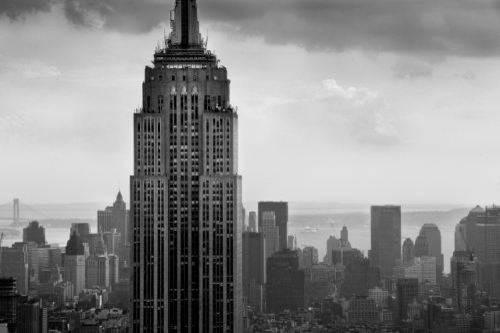
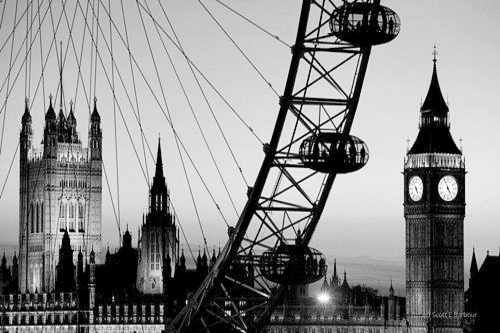
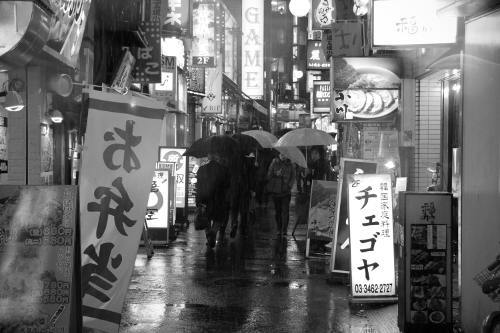
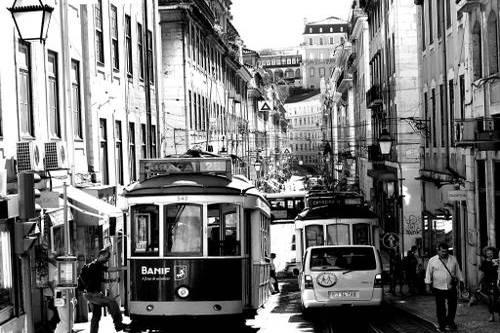
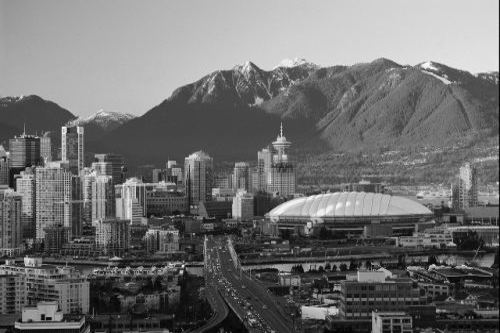
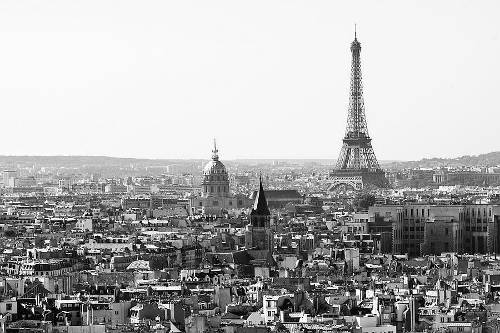
 The
The 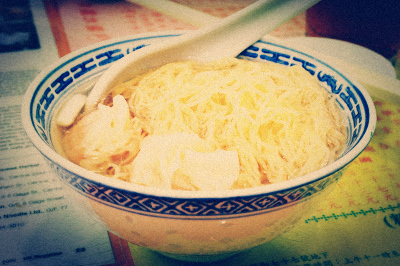 You're spoiled for choice for Wonton Noodles, Congee, and places specializing
in meatball and noodle soup. Try
You're spoiled for choice for Wonton Noodles, Congee, and places specializing
in meatball and noodle soup. Try 
 For a more upscale experience, try the dim sum at the 2-Michelin Star rated
For a more upscale experience, try the dim sum at the 2-Michelin Star rated
 Owing both to its colonial heritage and to its local afternoon tea traditions
(Dim Sum is typically called yum cha, meaning drink tea),
Owing both to its colonial heritage and to its local afternoon tea traditions
(Dim Sum is typically called yum cha, meaning drink tea),
 There are plenty of places in both Hong Kong Island and Kowloon to enjoy a drink out with
a view.
There are plenty of places in both Hong Kong Island and Kowloon to enjoy a drink out with
a view.  As the latest
As the latest